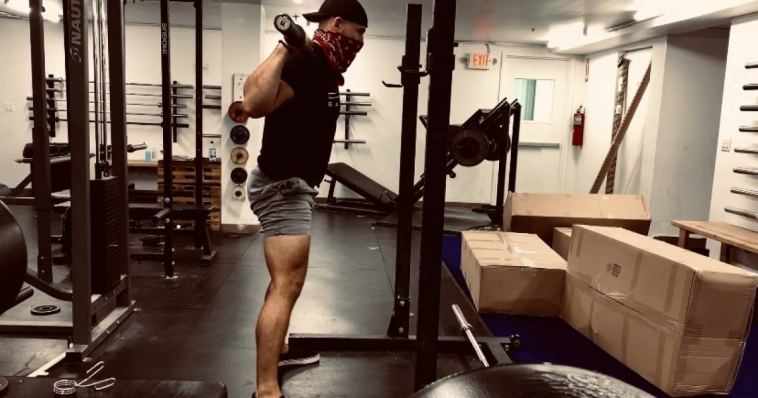- Like
- SHARE
- Digg
- Del
- Tumblr
- VKontakte
- Flattr
- Buffer
- Love This
- Save
- Odnoklassniki
- Meneame
- Blogger
- Amazon
- Yahoo Mail
- Gmail
- AOL
- Newsvine
- HackerNews
- Evernote
- MySpace
- Mail.ru
- Viadeo
- Line
- Comments
- Yummly
- SMS
- Viber
- Telegram
- JOIN
- Skype
- Facebook Messenger
- Kakao
- LiveJournal
- Yammer
- Edgar
- Fintel
- Mix
- Instapaper
- Copy Link
We all know we shouldn’t look like we’re bowing to worship the gym floor when we do a barbell back squat. That’s a lot of what you see at gyms, though.
So, we do corrective exercises that focus on building strength and stability for the muscles and patterns that would supposedly keep this from happening.
These are usually simple and single-joint exercises that work on only one side of the body at a time. But sometimes, and more often than not, we can develop what we need by just spending more time in the positions we want to improve.
If you want to learn all about the principles behind this, check out my online course starting in a couple of weeks.
Addressing Posture and Position in the Squat
Moving through positions is what the 1.25 squat does best.
It keeps you moving through the positions that are frequently harder to maintain.
More time practicing the bottom positions of the squat means we have more opportunity for sensory learning – feeling the muscles that contribute to a movement where and when they should.
The continuous controlled movement from the bottom of your squat to a quarter standing, back down to the base causes you to maintain the type of balance and posture that creates a great squat.
It’s better than just doing more straight reps because of how challenging it is to lower into that second squat without resetting at the top like you usually would. It helps you feel any shift in the pressure of your feet and the tilt of your torso.
The Benefits of the 1.25 Squat
Some exercises are just variations for advanced lifters who need some new kick to get stronger.
It does that, but it’s also great for inexperienced squatters.
It can be a focused movement practice for anyone trying to make their squat pattern fluid and strong. And, it can be a way for someone who already has an ingrained good squat to strengthen their quads and glutes while they work on the skill of keeping ample tension at a depth of their squat.
The 1.25 squat doesn’t just strengthen and train the coordination of the muscles that do the moving.
It provides a condition that naturally trains the stabilizing musculature of the trunk. Muscles like the abs, obliques, the transverse abdominis, and the erectors stiffen the spine.
Posture breaks down, and squats fall apart because of a lack of control over these muscles during the most challenging part of the movement (reversing from the bottom to standing back up).
With this exercise, you train this capacity for tension better because you spend most of your time in that part of the movement.
How To Brace, Lower, and Hit Your Squat
Set up under the barbell and walk out just as you’d do for a standard squat, Take your breath, and make sure to focus on creating a proper brace. You’ll need it to stay rigid for this extended rep.
Lower into your squat and once you hit your depth, come up a quarter of the way to completely standing. Think of coming up 3-5 inches above parallel.
Immediately go back to the depth of your squat and then stand up entirely from there. That’s one rep.
Make sure not to pause at any point.
- As soon as you reach depth, come up.
- Once you feel like you’re 3-5 inches above parallel, immediately go back down.
- When you reach the bottom of your squat for the second time, stand up completely without hesitation.
Don’t do more than five reps on this exercise, and be aware of how much weight you use.
The focus is on the quality of the movement, posture, tension, and feeling the muscles working well in one coordinated effort.
Don’t worry if you’re coming too high or not high enough on the quarter rep. If you’re going in-and-out of the bottom of your squat twice, you’re doing the exercise correctly.
Change It Up
The point of this exercise is to make sure the right muscles are working where they should and to increase stability in the movement where you’d often lose it.
The muscles of the upper-back aid in creating a structure and posture that you need for a solid squat, so a 1.25 front squat can be a significant variation to this end.
Front squats require that you keep tension in your upper back and keep the chest from falling forward because if you don’t, you’re dumping the bar on the floor in front of you.
Rotating 1.25 front squats with back squats will improve the posture and muscular coordination for a strong squat.
Challenge Your Squat Technique With Pauses
This exercise can be pretty tricky, even if you have a lot of experience.
But if you’ve been training with them, try adding pauses.
Pauses force even more control to keep tension in these positions because you’re spending even more time at the bottom.
Using a one count pause at the bottom of the squat, again after you rise a quarter of the way up, and then also the second time at the bottom is plenty to challenge and advance you for some time.





